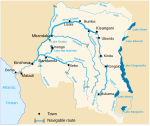Kwilu River
| Kwilu River | |
|---|---|
 May, 2003 - Villagers crossing the Kwilu river | |
 The Kwilu River in the Kasai catchment (center) | |
| Location | |
| Countries | |
| Physical characteristics | |
| Mouth | |
• coordinates | 3°23′07″S 17°23′04″E / 3.385251°S 17.384491°ECoordinates: 3°23′07″S 17°23′04″E / 3.385251°S 17.384491°E |
| Length | 965 km (600 mi) |
| Basin features | |
| River system | Kasaï River |
The Kwilu River (or Quilo River) is a major river that originates in Angola and flows north through Bandundu Province in the Democratic Republic of the Congo (DRC) to the city of Bandundu, where it joins the Kwango River just before this stream enters the Kasai River. In the DRC the river flows past the towns of Gungu, Kikwit, Bulungu, Bagata, Rutherfordia and Bandundu.[1] Lusanga, formerly Leverville, lies at the location where the Kwenge River joins the Kwilu, between Kikwit and Bulungu.[2]
Characteristics[]
It is a meandering river. Near its mouth it is 950 meter wide. The bed material is sand.[3] The river is about 965 kilometres (600 mi) long. In the wet season the flooded area covers 1,550 square kilometres (600 sq mi). The headwaters of the river rise at elevations between 1,000 metres (3,300 ft) and 1,800 metres (5,900 ft) in the Angolan highlands. They drop steeply to the flat central Congo Basin at between 500 metres (1,600 ft) and 300 metres (980 ft) above sea level. A 2011 survey found 113 species of fish in 21 families and eight orders.[4]
Same name rivers in South west DRC and north west Angola[]
Just south of the city of Kwilu Ngongo two other rivers name Kwilu are merging together at coordinate point 5°34'52"S 14°37'43"E
References[]
- ^ Blaes 2008.
- ^ C.J. Warrington (May 1972). "M'Bwa na Basenji" (PDF). The Basenji. Retrieved 2012-02-02.
- ^ Hanibal Lemma, and colleagues (2019). "Bedload transport measurements in the Gilgel Abay River, Lake Tana Basin, Ethiopia (Table 7)". Journal of Hydrology. 577: 123968. doi:10.1016/j.jhydrol.2019.123968.
- ^ Munene & Stiassny 2011.
Sources[]
- Blaes, X. (October 2008). "Découpage administratif de la République Démocratique du Congo" (PDF). UNOCHA and PNUD. Archived from the original (PDF) on 2016-08-18. Retrieved 2011-11-22.
- Munene, José Justin Mbimbi Mayi; Stiassny, Melanie L. J. (2011). "Fishes of the Kwilu River (Kasai basin, central Africa): A list of species collected in the vicinity of Kikwit, Bandundu Province, Democratic Republic of Congo". Check List. 7 (5): 691. doi:10.15560/7.5.691. Archived from the original on 2016-03-04. Retrieved 2012-02-02.
- Rivers of the Democratic Republic of the Congo
- Rivers of Angola
- International rivers of Africa
- Africa river stubs
- Angola geography stubs
- Democratic Republic of the Congo geography stubs



